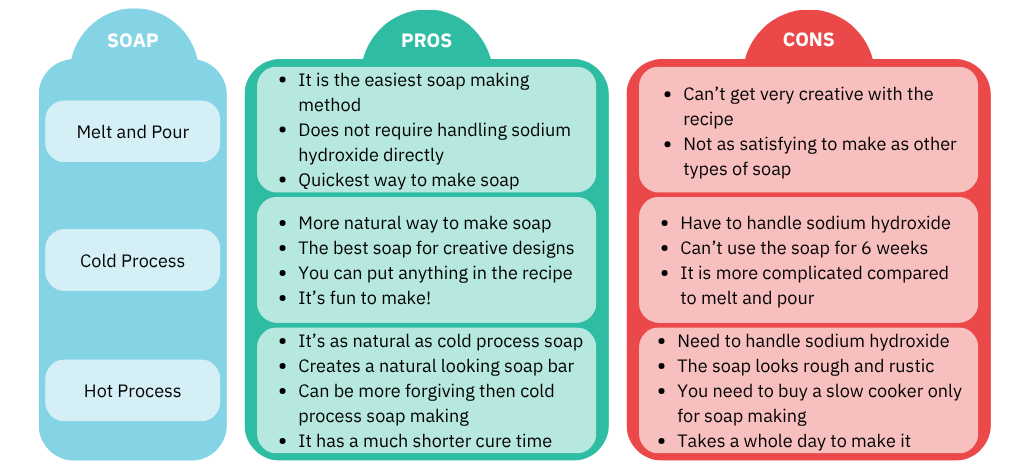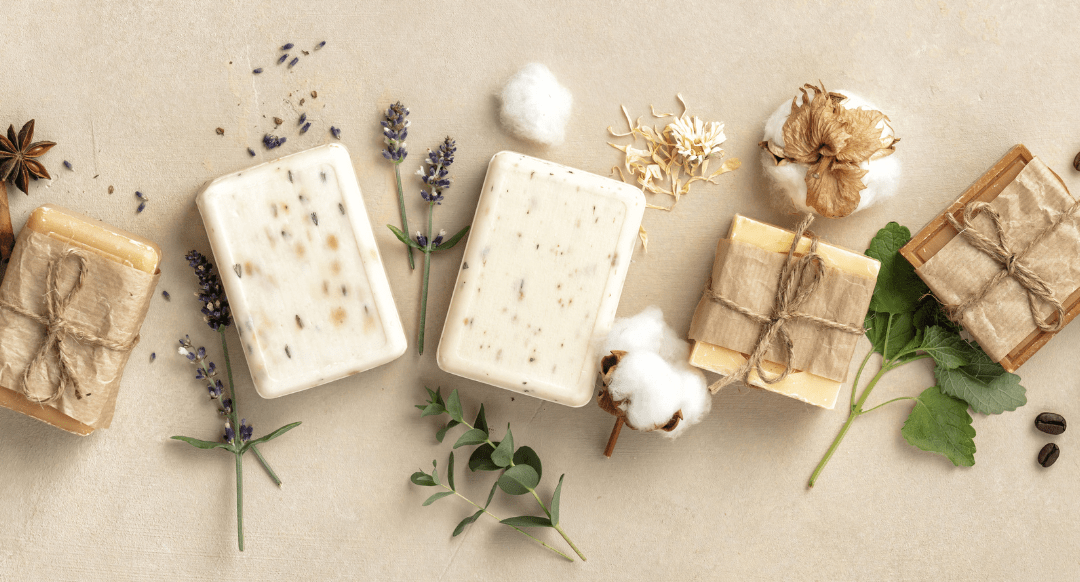Want to learn how to make soap but don't know where to start?
You’ve come to the right place! As soap making experts, we want to share everything we’ve learnt over the years when it comes to soap making.
So let’s get started…
Contents
- Where Do You Start?
- What Soap Making Methods Are There?
- What is Sodium Hydroxide?
- What Type of Soap Should You Make?
- Final Thoughts
Where Do You Start?
The truth is, it’s not as simple as just making soap. There are a few different ways to make soap from melt and pour to cold process or hot process. So you need to figure out the best one for you!
Already know which one you want to try? If you do then go straight to our beginners guides:
- How To Make Melt and Pour Soap (Beginners Guide)
- How To Make Cold Process Soap (Beginners Guide)
- How To Make Hot Process Soap (Beginners Guide)
If you have no idea what these are or where to start, don’t worry we’re going to help you to decide!

What Soap Making Methods Are There?
The three main types of soap making are:
- Melt and pour soap making
- Cold process soap making
- Hot process soap making
Each soap making method has its own pros and cons. If you are ready to decide straight away, skip to here.
But first, let's look into each type of soap in a little bit more detail…
Melt and Pour Soap Making
Melt and pour soap making involves melting a premade soap base, adding fragrance and colour and leaving it to set in a soap mould.
This soap can be used as soon as it has set and it is a great introduction to soap making.
Melt and pour soap making is the quickest and easiest way to make your own soap at home. However, it is not as natural as other soap making methods.
Cold Process Soap Making
Cold process soap making involves combining oil, water and sodium hydroxide to make a solid soap bar.
It is one of the more natural ways to make soap and gives you complete freedom to create any type of recipe. However, this soap making method does involve handling sodium hydroxide and the soap cannot be used until 4 to 6 weeks after making the soap.
Hot Process Soap Making
Hot process soap making is the process of cooking the soap mixture in a slow cooker above 50°C.
It is a traditional, more natural way to make soap and it can be used after the soap has set. However, the soap looks very rustic and you do need to handle sodium hydroxide directly.

What is Sodium Hydroxide?
Before we move on, let’s discuss what sodium hydroxide is…
Sodium hydroxide is a key ingredient in soap making as it saponifies the oil and water together to make soap.
However, pure sodium hydroxide is a highly caustic substance that must be handled carefully.
So how should you handle sodium hydroxide?
You must wear gloves, a mask, safety goggles and long-sleeves. Also ensure you are working in a well-ventilated room (so open a window), otherwise you may need a respiratory mask.
Contact with the skin will cause severe skin burns, and the inhalation of vapours can cause irritation. Keep out of reach of children and pets.
When adding caustic soda to water it can become quite hot and the fumes can be quite unpleasant, so ensure the room is well ventilated and do not directly breath in the fumes.
Never add water to sodium hydroxide, always add sodium hydroxide to water. This helps prevent overheating and splashing of highly concentrated sodium hydroxide.
Make sure you don't mix your soap making tools with food preparation tools. Your soap making tools will have caustic soda residue on them and need to be washed thoroughly before they are safe to handle. But you won't want to cook with them!
Now you understand what sodium hydroxide is and how to handle it, you can make an informed decision on the type of soap you want to make!
What Type of Soap Should You Make?
It’s hard to choose our favourite way of making soap as we love them all!
Here’s a breakdown of the pros and cons of each type:

If you want a simple soap bar that is quick to make and you don’t want to handle sodium hydroxide, then melt and pour soap is for you.
If you have sensitive skin or want to make a colourful swirled soap design, then cold process soap is the perfect choice.
If you are looking for something different, more natural and don’t mind getting a new slow cooker, then try hot process soap making.
At The Soapery, we believe everyone should try a melt and pour soap recipe at least once before attempting a cold process or hot process soap recipe! It’s a great way to ease yourself into it and get an understanding of soap.
Ready to make some soap? Choose your beginners guide to soap making:
- How To Make Melt and Pour Soap (Beginners Guide)
- How To Make Cold Process Soap (Beginners Guide)
- How To Make Hot Process Soap (Beginners Guide)
Each of our guides include a simple recipe for you to try and lots of information and tips from our soap making experts!
Final Thoughts
Now you know which type of soap you are going to make, you can get stuck in!
It may be daunting starting your soap making journey, but don’t worry if you mess up! We all have. Many times. But it’s how you learn and become a pro!
So it's time to throw out commercial soaps and make your own!
Once you've mastered these simple recipes, you can get creative with our wide variety of soap making recipes!
Continue Reading
Now you know how to make soap, why not learn how to make other cosmetics?
- Looking for a soap recipe with coconut oil? Check out our hot process coconut soap recipe!
- Want to try the cold process method? Try our simple cold process soap recipe with shea butter!
- Try melt and pour soap with our lavender melt and pour soap recipe!
How did your handmade soap turn out? Comment below and let us know!



